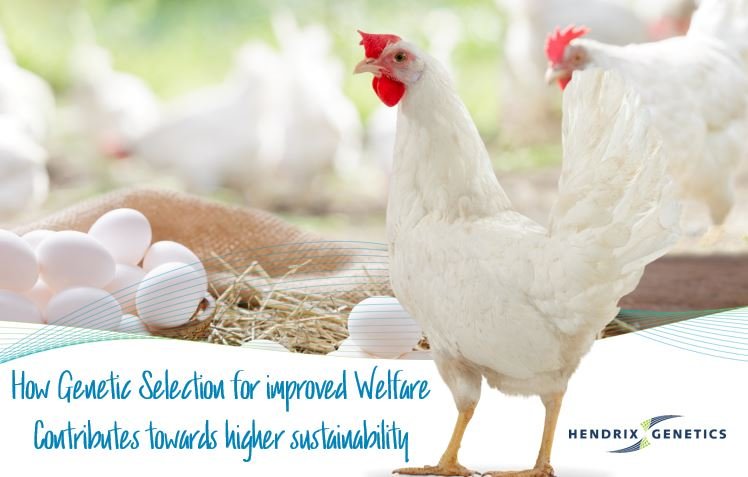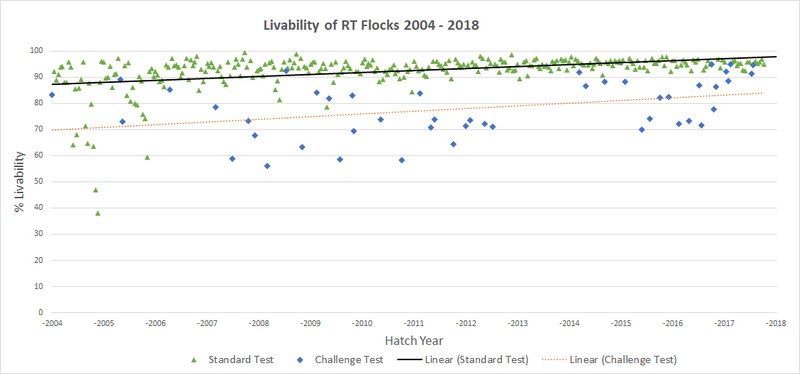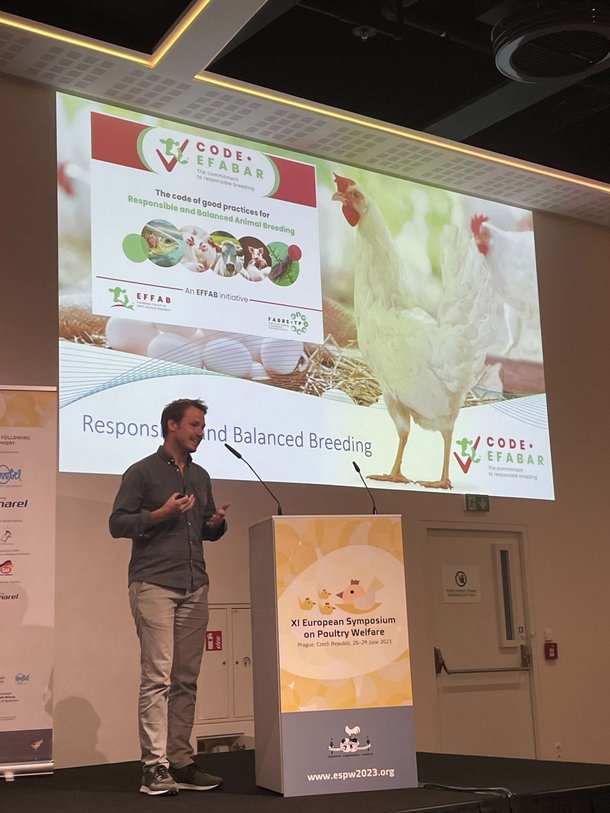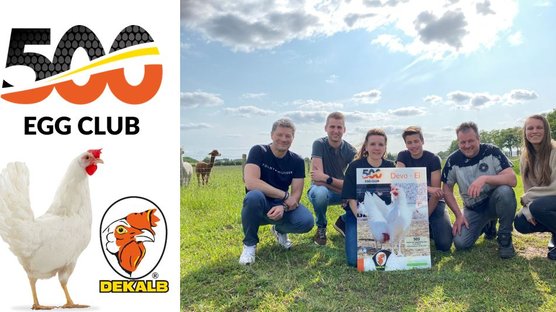
Published on June 28, 2023
Selecting for improved animal welfare contributes to more sustainable production of eggs
In Europe and North America there has been a strong consumer demand to take welfare into account in animal production. Table egg consumption patterns have seen a major shift from cage to non-cage production systems because of societal pressures. This shift likely signals the future direction for the layer sector in developed countries with the acceleration of the conversion of cage to barn and aviary systems with access to wintergardens or the outdoors.
Next to many advantages as the hens are much better able to express their natural behavior’s, this shift can come with unintended consequences for the welfare of the hens, from bone fracture to increased disease exposure, and for the environment as cage-free housing systems have a bigger negative impact on the environment, all requiring solutions. One of the directions to improve the sustainability of the production of eggs, whilst improving the hens’ welfare, is breeding for longer production cycles. As laying hens are born with the potential to produce more than one-thousand eggs, whilst this is not visible yet in the field, there is less selection pressure on selecting birds that can produce more eggs. The focus of todays’ breeding program is therefor on the hens’ health and wellbeing. The higher their health status and their overall robustness, the better their chances to survive and remaining productive. Also, from the farm economics point of view it makes sense to select for improved livability. Mortality not only comes at a big cost for egg producers, but it also has its impact on the motivation and mood of egg producers, as no single egg producer likes to collect dead hens from their barns.
With increasing numbers of laying hens kept in cage-free housing systems, (currently more than 10% of the worlds laying hen population is kept cage free), the importance of successful rearing is more important than ever. The rearing period is a crucial period in the hen’s life, as this is the period that the basis for a successful productive life is formed. The goal is to select pullets that have the genetic potential to grow well so they can develop a robust frame, with good feather cover, but also with sufficient appetite. Since the beginning of genetic selection hens became earlier sexual mature and have become smaller in size. This is a development that has been stopped during the past 15 years as it is acknowledged that birds that are kept for longer production cycles, without forced molting, need the time to develop as the onset of lay can be a challenging event in the lifetime of a hen. Transfer of hens is always accompanied with stress: in all housing systems the hens need to adjust to a new environment, accompanied with plenty of new faces. The goal is to select hens that can deal with these challenges, one of the most important traits to select for is their appetite. It might sound contradictory, but you want birds that can drink and eat well. This well support the hens in their development, hens continue to grow and develop till around 30-35 weeks of age, and they start to produce their first eggs around 20 weeks of age. Next to the energetical needs for maintenance, they require energy for both growth and production. Good appetite will allow the hens to overcome any potential deficiencies that could occur due to the onset of lay. This will prevent the hens from using their own reserves, allowing them to continue their growth till adulthood.
Injurious pecking and cannibalistic behavior are among the most common causes of mortality in laying hens. With intact beaks and/or larger group sizes it is more challenging to control any unwanted behavior in laying hens. Genetic selection towards social behavior and implementing new genetic models that include the social effects have been developed and implemented in recent decades. This has resulted in a 50% reduction of the mortality during the past 2 decades. As heritabilities for livability are getting smaller with every new round of selection it will become more difficult to achieve the same speed of genetic progress in the future. But as long as there is room for improvement, intensive selection pressure will be put on improving livability.

Selecting laying hens that maintain good condition at older age, which allows them to maintain their production of 1st quality eggs improves the environmental footprint of egg production. An increasing number of white egg layer flocks already produce till 100 weeks of age or even longer, thereby reducing the number of laying hen replacements and improving both the economics and sustainability. Differences in behavior and performance exist between different hybrid chicken breeds. The different brown and white egg laying strains are centuries apart from each other, resulting in different response to selection. When looking to the accomplishments on genetic improvement in recent decades, it is expected that the gap between brown and white laying hens in terms of behavior and performance is becoming bigger in the future. Resulting in a higher positive ranking of white egg layers breeds in terms of sustainability and animal welfare.
Cag-free housing systems require different capabilities of laying hens compared to those housed in (enriched) cages. The genetics of laying hen behavior in cage free housing systems is thus far poorly understood. Research collaborations, like with HenTrack (University of Bern, Switzerland), are therefor in place to gain a better understanding of the genetic involvement in the phenotypic differences that are observed in cage-free flocks. Another project is the IMAGEN project, (AnIMAl Group SENsor), which is a multi-faceted, long-term study that combines animal breeding with advances in sensing and AI technologies to help in the transition towards sustainable livestock production. By combining sensing and AI technology with animal breeding and genetics, this project aims to improve the health and welfare of livestock and reduce the ecological footprint of our food production.
A major ethical issue for the egg industry is the culling of male day-old chicks of layer breeds as the meat of the males cannot be easily marketed. Much research has and will be devoted to alternatives. Among the available solutions are in ovo sexing and dual-purpose chicken breeds. The various dual-purpose strains are less efficient and currently do not compete economically in poultry meat or egg markets. Several commercially viable in-ovo sexing techniques have become available in recent years. From a genetic point of view, research has been performed after finding a deleterious allele that could cause a “natural” death of the male embryo or on genetic engineering. So far, only the latter has been successfully developed at research institutes. But adopting and implementing the genetic engineering technology in practice comes along with an ethical debate, with strong No’s and strong Go’s.
As consumer awareness increases viable markets could emerge in the future. These priorities are the response to economic, environmental, ethical and consumer pressures that are already having a strong impact on the egg industry. They will continue to evolve in the next decade and if supported by a strong research and development effort, a more efficient and ethical egg-laying industry could emerge. The poultry breeding companies, that remain today, have placed both animal welfare and sustainability high on their research agendas. In todays’ world, where we are dealing with climate change, rising food insecurity and an increasing need for animal-worthy livestock farming, one cannot go without another.
the breeding program of Hendrix Genetics Layers has resulted in a reduction of flock mortality of 50% during the past 20 years




